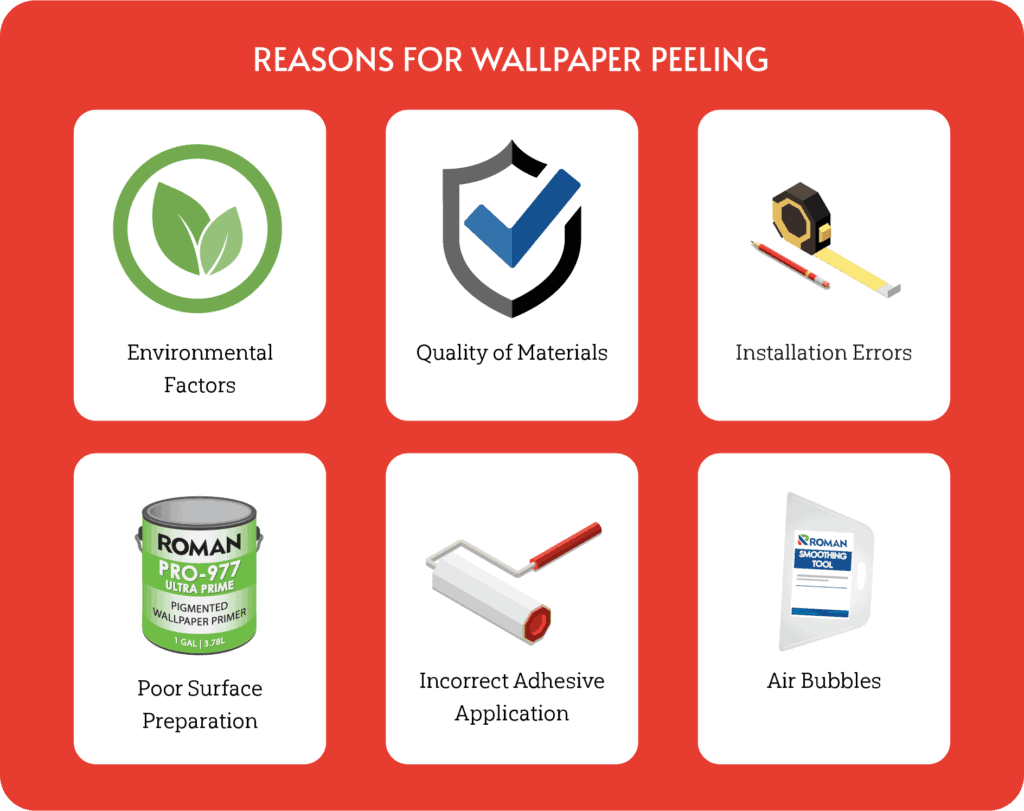Peeling wallpaper can be a frustrating and unsightly issue that disrupts the aesthetics of your home. Whether you’ve encountered small, isolated areas of peeling or your entire wallpaper seems to be coming undone, understanding the composition of your wallpaper and the reasons behind its peeling is essential to address the problem effectively.
Below, the experts at ROMAN Products will outline the key factors influencing wallpaper peeling and provide practical solutions to fix it. Let’s start by gaining a deeper understanding of wallpaper composition and types.
Reasons for Wallpaper Peeling
Understanding why wallpaper peels is essential for effective solutions. Several factors contribute to wallpaper peeling:
- Environmental Factors – High humidity or extreme temperature fluctuations can weaken the adhesive bond of wallpaper over time. Wet areas like bathrooms and kitchens are particularly susceptible.
- Quality of Materials – Using high-quality adhesives and primers, such as those from ROMAN Products, is vital for long-lasting wallpaper adhesion. These products are designed to enhance the bond between the wallpaper and the wall.
- Installation Errors – Incorrect wallpaper installation techniques can lead to peeling. It’s essential to follow manufacturer guidelines for installation, including using the recommended tools and procedures.
- Poor Surface Preparation – Walls must be clean, dry, and smooth before applying wallpaper. Applying a primer, such as those from ROMAN Products, can further enhance adhesion, creating a suitable surface for wallpaper installation.
- Incorrect Adhesive Application – Uneven or insufficient adhesive application can result in wallpaper peeling. ROMAN’s adhesives are formulated for easy and effective application, ensuring a secure bond.
- Air Bubbles – Air bubbles trapped under the wallpaper can lead to peeling. It’s essential to use the right tools like smoothers and rollers during installation to eliminate air bubbles and ensure a smooth, adhesive bond.

It’s also important to recognize the different types of wallpaper and their relative proneness to peeling:
- Vinyl Wallpaper – Vinyl wallpaper is generally more durable and less prone to peeling. Its protective vinyl coating makes it an excellent choice for high-moisture areas like bathrooms and kitchens.
- Paper-Based Wallpaper – Paper-based wallpaper may be more susceptible to moisture and is more prone to peeling in humid conditions.
- Adhesive Compatibility – Mismatching the adhesive with the wallpaper can lead to peeling. ROMAN Products offers a range of adhesives suitable for different wallpaper types, ensuring a secure bond.
- Wallpaper Thickness – Thicker wallpaper is generally less likely to peel than thinner ones. Due to its surface irregularities, textured wallpaper may require a stronger adhesive to stick properly.
In the next sections of this guide, we will provide step-by-step instructions on how to fix peeling wallpaper effectively.

Repairing Peeling Wallpaper
Before you begin, it’s vital to have the right products for the type of wallcovering material you’re working with. You can always come to ROMAN Products for the finest wallcovering adhesives and accessories on the market today.
Here’s how to repair wallpaper that is peeling:
Step 1: Identify the Peeling Area
Gently peel back the loose wallpaper until you reach a section that is still well adhered to the wall.
Step 2: Clean the Wall
Clean the exposed wall thoroughly to remove any residue or contaminants. Use a light-grade cleaning solution and a clean cloth or sponge. Ensure the wall is dry before proceeding.
Step 3: Apply the Right Adhesive
Select the appropriate adhesive for your wallpaper type. ROMAN Products offers a range of adhesives suitable for different wallpaper types. Apply your wallpaper repair adhesive evenly and adequately to the cleaned surface.
Step 4: Smooth Out the Wallpaper
Carefully reposition the peeling or loose wallpaper section back onto the adhesive-coated wall. Starting from the center of the paper, use a plastic smoothing tool or a wallpaper roller to smooth out any air bubbles and wrinkles. Work outward towards the seams to ensure a seamless bond.
Step 5: Clean Excess Adhesive
Inspect the seams and edges for any excess adhesive that may have squeezed out. Clean up any excess adhesive promptly using a wet rag or sponge.
Step 6: Allow Proper Drying Time
Give the reattached wallpaper ample time to dry and set. The drying time may vary depending on the type of adhesive used, so refer to the adhesive manufacturer’s instructions for guidance.
Step 7: Monitor and Maintain
Regularly inspect your wallpaper for any signs of further peeling or adhesion issues.
By following these steps, you can effectively fix peeling wallpaper and ensure a secure and long-lasting bond between the wallpaper and the wall surface.

Advanced Repair Techniques
In some cases, fixing peeling wallpaper may require more advanced techniques, especially if you’re dealing with severe peeling and damage or delicate wallpaper.
Addressing Severe Peeling and Damage
(a) Assessing the Extent
Determine whether the wallpaper can be salvaged or if replacement is necessary.
(b) Removing Damaged Sections
Gently lift and peel away the damaged portions with a sharp utility knife or wallpaper scraper.
(c) Reapplication Process
To repair severe peeling or damaged sections, follow these steps:
- Apply a fresh coat of adhesive, ideally using high-strength adhesives from ROMAN Products.
- Carefully align the wallpaper with the existing design. Smooth out the wallpaper using a plastic smoothing tool or wallpaper roller.
By carefully following these advanced repair techniques, you can salvage sections of peeling or damaged wallpaper and restore the overall appearance of your walls.
Techniques for Textured or Delicate Wallpaper
(a) Gentle Handling
Handle delicate wallpaper carefully to prevent tears or damage.
(b) Special Adhesives
Opt for a mild adhesive specifically designed for delicate wallpaper to prevent damage.
(c) Appropriate Tools
Use soft brushes or sponges to apply and smooth out the wallpaper.
For first-rate wallpaper adhesives, removers, and accessories, check out the ROMAN Products catalog. You can visit us online at RomanDecoratingProducts.com





